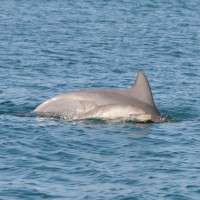New report reveals insights into Swan River dolphin population

(Phys.org)—A new report by Murdoch University researchers on dolphins in the Swan Canning Riverpark has shown that a core group of around 20 dolphins are resident year-round in the estuary, while 16 others make occasional visits throughout the year.
The report prepared for the Swan River Trust identified 36 individual dolphins – including nine mother-and-calf pairs – using the river system in 2011-12.
At least 20 dolphins (16 adults and four calves) make up a resident "community" within the Riverpark. These dolphins range throughout the estuary and also use coastal areas such as Owen Anchorage off Fremantle.
Another seven (five adults and two calves) are occasional visitors to the estuary, while the remaining nine (six adults and three calves) occurred very infrequently.
Research for the report constituted the first study of the Swan River dolphin population since 2009 when six river dolphins died. The report confirms that cetacean morbillivirus played a role in at least two of the deaths.
This is the first report of the virus for marine mammals in Western Australia. The virus may have affected other dolphin and cetacean populations in 2009, as wildlife officers from the Department of Environment and Conservation documented a spike in mortalities and strandings of whales and dolphins along the Western Australian coast that year.
In the report, Murdoch researchers recommend making the Swan Canning Riverpark a dolphin sanctuary, similar to the Adelaide Dolphin Sanctuary in South Australia.
Dr Hugh Finn from the Murdoch University Cetacean Research Unit (MUCRU), said a sanctuary would help integrate management efforts across stakeholder groups and focus community support on protecting dolphins and dolphin habitat.
"The River Protection Strategy for the Swan Canning Riverpark, which is currently waiting for ministerial approval, would, if fully implemented, go a long way towards the aim of establishing a comprehensive catchment and estuary management system," he said. "The best long term strategy for the dolphins in the river is a healthy estuary ecosystem."
The research also provides an insight into dolphin society. Both males and females maintain relationships with other dolphins of the same sex, but associations between males tend to be stronger. The report found that males tend to be "constant companions" of each other, while females have a looser network of "casual acquaintances".
Murdoch University researcher Delphine Chabanne, who conducted the field study, said: "We are beginning to unravel the history and the social fabric of these dolphins. One of the calves from the 2001-3 study, Moon, now has her own calf Night, which is the first documented case of a third generation river dolphin."
Two male associates – Backpack and Fingers – who occasionally visit the estuary were first observed almost 20 years ago in Cockburn Sound. They likely visit the estuary searching for females. Similarly, resident males sometimes brought females from coastal areas into the Riverpark, possibly as a tactic to keep them away from other males. At least two of the visiting females with calves were observed with resident males in these apparent "consort" relationships. However, the report found the 'resident' dolphins generally associated preferentially with each other in distinct groups.
The research confirms that seven of the 20 resident dolphins have frequented the river for at least a decade, including three males (Hii, Bottomslice and Blackwall) and four females (Highnitch, Moon, Tupac and Tworakes), who each have dependent calves (Highhope, Night, Gizmo and Zari).
Provided by Murdoch University


















